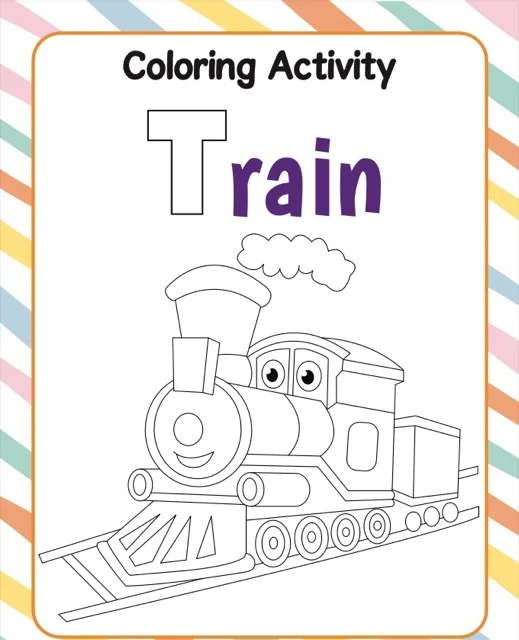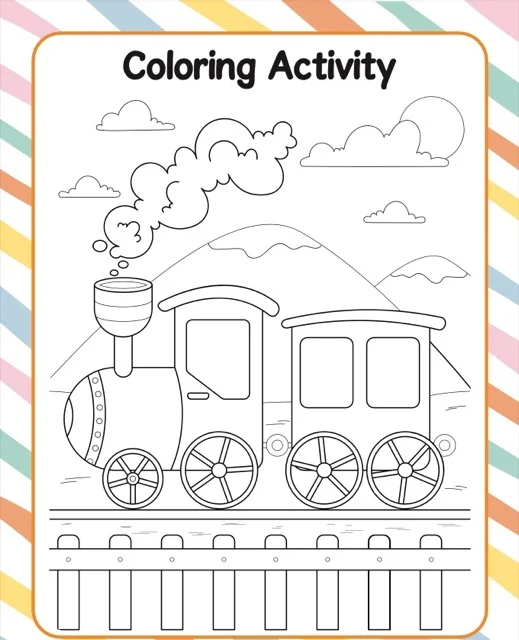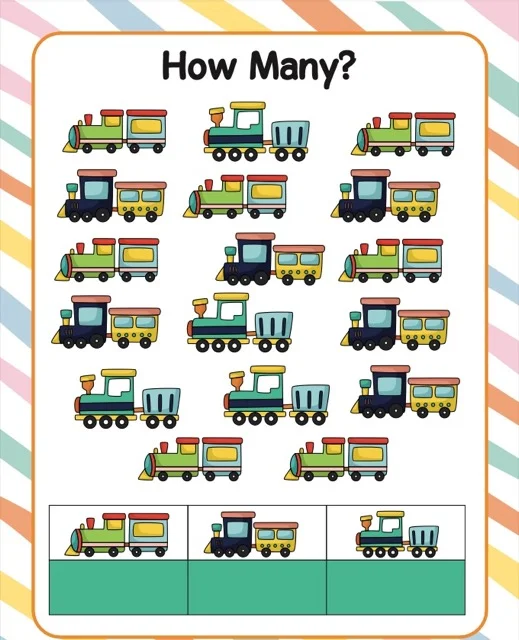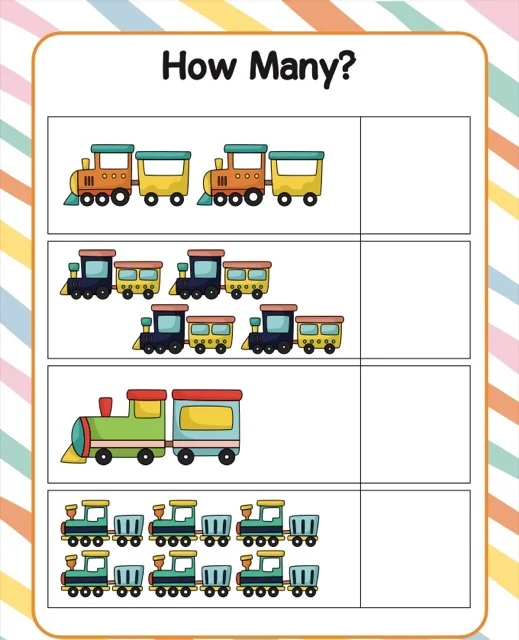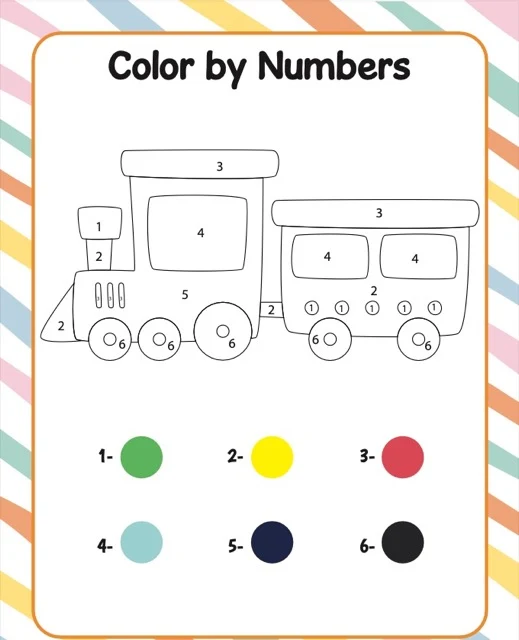Train-Themed Preschool Activities
This document reviews preschool train-themed learning activities designed for children aged 3-6. The activities promote various developmental skills, including fine motor, cognitive, creative, and language development, through printable resources like coloring pages, tracing exercises, and crafts. A study guide and FAQ offer educators adaptable lesson plans and suggest integrating books, toys, and field trips to enhance learning. The materials emphasize reusability and differentiated instruction to cater to diverse learners. Overall, the resources provide a comprehensive and engaging approach to early childhood education.
Preschool Train Activities: A Comprehensive Guide
All Aboard the Learning Train: A Review of Preschool Train Activities
This briefing document reviews a collection of resources focused on train-themed activities for preschool education. The materials include excerpts from "Preschool Train Activities" and its accompanying "Study Guide," as well as examples from the printable activity resource, "Testing Theme: Train Activities.pdf.”
Target Audience and Developmental Goals
The primary audience for these activities is preschool and kindergarten children, typically ages 3-6. The resources emphasize the role of train activities in fostering a range of developmental skills, including:
●
Fine Motor Skills: Activities like "Coloring," "Tracing," "Cutting, and Pasting" require precise hand movements, as highlighted in the "Preschool Train Activities FAQ." Examples from the "Testing Theme: Train Activities.pdf" demonstrate this with tasks like tracing train outlines and cutting out train car parts to be pasted together.
●
Cognitive Skills: The "Study Guide" explains that activities like "Matching, Sorting, and Counting" encourage logical thinking, problem-solving, and early math concepts. "Testing Theme: Train Activities.pdf" includes examples like matching train cars to their shadows and counting train cars.
●
Creativity: The materials consistently emphasize the role of train activities in promoting creativity and self-expression. The "Train Craft" activity in the printable resource provides a template for children to create their own train using various materials.
●
Language Development: Activities like naming train parts and describing train actions are mentioned in the "FAQ" as ways to enhance vocabulary and communication skills. This is reinforced in the "Study Guide," which suggests using books about trains to expand vocabulary.
Types of Activities
The "Preschool Train Activities" resource includes a variety of printable activities, including:
●
Coloring Pages: Children can color different trains and train-related scenes, promoting fine motor skills and creativity.
●
Tracing Activities: Tracing dotted lines helps develop pre-writing skills, as exemplified in the "Testing Theme" resource.
●
Matching Activities: Activities like matching train cars to shadows or connecting trains based on similar features are present in the printable resource.
●
Counting Activities: Counting train cars or wheels, as seen in "Testing Theme: Train Activities.pdf", helps with number recognition and counting skills.
●
Cutting and Pasting Activities: These activities, demonstrated in the printable resource, promote fine motor control and spatial reasoning.
●
Train Crafts: Children can create their own trains using printable templates and materials like cardboard or construction paper, as shown in the "Train Craft" activity.
Adaptability and Integration
A key strength highlighted in the "FAQ" and "Study Guide" is the adaptability of these activities for different learning levels. Suggestions include simplifying tasks for younger children and introducing more challenging variations for older children. The "Study Guide" further emphasizes integrating these activities into various classroom settings, including individual work, small group activities, and learning centers.
Beyond Printable Activities
The "Preschool Train Activities" resources recommend supplementing printable activities with:
●
Books About Trains: Reading aloud stories about trains can spark interest, expand vocabulary, and provide context for activities, as noted in the "Study Guide."
●
Train Toys: Providing toy trains and tracks encourages imaginative play and hands-on learning, allowing children to explore concepts like movement and speed.
●
Field Trips: Visiting train stations or museums can offer real-world experiences related to trains, enhancing learning.
Benefits for Educators
The "Study Guide" highlights the benefits of using these resources for educators:
●
Reusability: Activities like matching games and train crafts can be laminated or made with durable materials, reducing the need for constant printing and saving time and resources.
●
Differentiated Instruction: Train activities can be easily adapted to different learning levels, supporting diverse learners with varying needs and styles.
●
Integration of Developmental Domains: Train activities can be used to effectively address cognitive, physical, and social-emotional development.
Overall Assessment
The "Preschool Train Activities" resources offer a comprehensive collection of materials for engaging preschoolers in learning through a train theme. The printable activities provide a strong foundation, while the "FAQ" and "Study Guide" offer valuable guidance for implementation and adaptation. The inclusion of suggestions for supplemental resources further strengthens the overall value of these materials for educators seeking to create enriching and stimulating learning experiences for young children.
Preschool Train Activities
Train Activities FAQ
1. What age group are these train activities suitable for?
These activities are primarily designed for preschool and kindergarten children, typically between the ages of 3 and 6. However, older children who enjoy trains or need additional practice with certain skills may also find them engaging.
2. What skills can children develop through these train activities?
The activities target various developmental skills, including:
●
Fine motor skills: Coloring, tracing, cutting, and pasting require precise hand movements.
●
Cognitive skills: Activities like matching, sorting, and counting promote logical thinking, problem-solving, and early math concepts.
●
Creativity: Crafting and imaginative play with trains encourage creativity and self-expression.
●
Language development: Activities involving naming train parts or describing train actions can enhance vocabulary and communication skills.
3. What types of train activities are included?
The resource includes a variety of activities, such as:
●
Coloring pages: Children can color different types of trains and train-related scenes.
●
Tracing activities: Tracing dotted lines helps develop pre-writing skills.
●
Matching activities: Children match train cars to their shadows or connect trains based on similar features.
●
Counting activities: Counting train cars or wheels helps with number recognition and counting skills.
●
Cutting and pasting activities: These activities promote fine motor control and spatial reasoning.
●
Train crafts: Children can create their own trains using printable templates and materials like cardboard or construction paper.
4. Are these activities suitable for classroom use?
Yes, these activities are ideal for classroom use in preschool, kindergarten, and early elementary settings. They can be used for individual work, small group activities, or learning centers.
5. Are the activities printable?
Yes, all the activities are printable. You can download and print the PDF file to use the activities offline.
6. Are the activities reusable?
Some activities, like coloring pages, are single-use. However, others like matching activities or train crafts can be reused multiple times with proper lamination or storage.
7. Can these activities be adapted for different learning levels?
Yes, the activities can be easily adapted for different learning levels. For younger children, you can simplify tasks or provide more assistance. For older children, you can introduce more challenging variations or encourage them to create their own train-themed stories or games.
8. What other resources can complement these train activities?
To enhance the learning experience, you can incorporate:
●
Books about trains: Read aloud stories about trains to spark interest and expand vocabulary.
●
Train toys: Provide toy trains and tracks for children to engage in imaginative play and hands-on learning.
●
Field trips: Visit a train station or museum to provide real-world experiences related to trains.
Preschool Train Activities Study Guide
All Aboard the Learning Train: A Preschool Train Activity Study Guide
Quiz
Instructions: Answer the following questions in 2-3 sentences each.
1.
What is the primary age group targeted by the "Preschool Train Activities"?
2.
Identify and explain three developmental skills that train activities can foster in preschool children.
3.
Describe two different types of train activities included in the resource "Testing Theme: Train Activities.pdf".
4.
Explain how train activities can be adapted for different learning levels within a preschool classroom.
5.
List three benefits of using coloring pages as a train activity for preschoolers.
6.
Explain the concept of "matching activities" and how they contribute to a child's development.
7.
What are the advantages of incorporating train crafts into preschool learning?
8.
Beyond the printable activities, suggest two additional resources that can enhance train-themed learning for preschoolers.
9.
How can train activities be integrated into a preschool classroom setting?
10.
Explain how the reusability of train activities can benefit educators.
Quiz Answer Key
1.
The "Preschool Train Activities" are primarily designed for preschool and kindergarten children, typically between the ages of 3 and 6. However, older children who enjoy trains or need extra support in certain skills can also benefit from them.
○
Fine motor skills: Activities like coloring, tracing, cutting, and pasting require precise hand movements, strengthening hand-eye coordination and dexterity.
○
Cognitive skills: Activities like matching, sorting, and counting promote logical thinking, problem-solving, and early math concepts, like number recognition and sequencing.
○
Creativity: Crafting and imaginative play with trains encourage creativity, self-expression, and imaginative thinking.
○
Color by Numbers: Children color sections of a train illustration according to a designated number and color key, practicing number recognition and color identification.
○
Cut and Paste: Children cut out train parts and paste them together to form a complete train, practicing fine motor skills, hand-eye coordination, and spatial reasoning.
2.
Train activities can be adapted to different learning levels. For younger children, educators can simplify tasks, like using larger shapes for cutting or providing fewer items to match. For older or more advanced students, educators can introduce more challenging variations or encourage them to create their own train-themed stories or games.
3.
Coloring pages help preschoolers develop fine motor skills by encouraging control over crayons or pencils. They can also boost creativity by allowing children to choose colors and express themselves through color choices. Coloring familiar objects like trains can also improve object recognition and color identification.
4.
Matching activities involve finding and connecting items based on shared characteristics. In the train theme, this could involve matching train cars to their shadows, types, or sizes. Matching activities develop cognitive skills like visual discrimination, logical thinking, and problem-solving, while also enhancing vocabulary as children learn to identify and name train attributes.
5.
Train crafts, such as building a train from cardboard or assembling a printable train, not only encourage creativity and self-expression but also develop fine motor skills like cutting, folding, and pasting. These activities also foster spatial reasoning as children figure out how to put the parts together to create a cohesive whole.
○
Books about trains: Reading aloud stories about trains can spark interest in the topic, expand vocabulary related to trains and transportation, and provide context for the train activities.
○
Train toys: Providing toy trains and tracks allows children to engage in imaginative play, hands-on learning, and further explore concepts like movement, speed, and different types of trains.
6.
Train activities can be integrated into various preschool classroom settings. They can be used for individual work, allowing children to practice skills at their own pace. They can also be implemented as small group activities, fostering collaboration and communication. And finally, they can be incorporated into learning centers, providing a designated space for train-themed exploration and play.
7.
The reusability of train activities, like matching games or train crafts, is beneficial for educators as it reduces the need for constant printing and preparation. By laminating activities or using durable materials, teachers can use them repeatedly, saving time and resources.
Essay Questions
1.
Discuss how train activities can be used to effectively integrate different developmental domains, such as cognitive, physical, and social-emotional development, in a preschool classroom.
2.
Analyze how train-themed activities can contribute to the development of early literacy skills in preschool children. Consider activities like storytelling, vocabulary building, and letter recognition.
3.
Explain how train activities can be used to support differentiated instruction in a preschool classroom, catering to the individual needs and learning styles of diverse learners.
4.
Critically evaluate the advantages and limitations of using printable activities like the ones featured in "Testing Theme: Train Activities.pdf" as a primary learning tool in preschool education.
5.
Design a comprehensive lesson plan for a preschool class using train activities as the central theme. Outline the learning objectives, the activities involved, and the assessment strategies you would employ.
Glossary of Key Terms
Cognitive Skills: Mental processes involved in thinking, learning, remembering, and problem-solving.Developmental Skills: Abilities and competencies that emerge and evolve as a child grows, encompassing physical, cognitive, social, emotional, and language domains.Fine Motor Skills: Small muscle movements requiring dexterity and coordination, such as those used in writing, drawing, and manipulating small objects.Imaginative Play: A type of play where children use their imagination to create scenarios, characters, and storylines, often using objects symbolically.Language Development: The process of acquiring and refining language skills, including vocabulary, grammar, and communication abilities.Matching Activities: Tasks that involve pairing objects or concepts based on shared characteristics, fostering visual discrimination, logical thinking, and categorization skills.Preschool: An educational setting for children typically between the ages of 3 and 5, focusing on early childhood development and school readiness.Train Activities: Educational tasks and games centered around the theme of trains, designed to engage children and foster various developmental skills.
